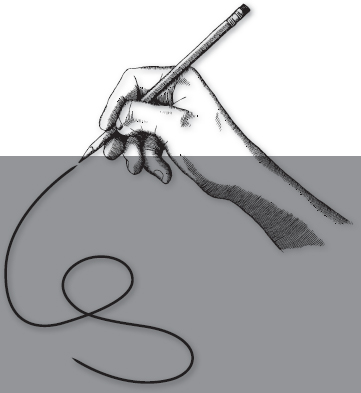
It is important to remember that the more indications you discover in a person's handwriting, and the longer the writing sample is, the better you will understand the writer. There are three basic slants to handwriting: the right-handed and left-handed slants and the upright slant. On occasion you may find a mixture of these.
A graphologist friend of mine has a novel way of remembering the slant indicators: Imagine three people who want a cup of tea. The writer with the left-hand slant would delegate someone else to make the tea, the writer with the upright slant would make him- or herself a cup of tea, and the writer with the right-hand slant would make everyone a cup of tea. We will now look at the various slants in handwriting and see what the differences indicate.
The right-leaning slant is found in the majority of people's handwriting. This most common slant can show a forward-looking person with a friendly disposition who enjoys human contact and who likes to be surrounded by others. People who display this characteristic have well-developed social instincts and may forget themselves in their interactions with others. These people are sociable and responsive, with good coping abilities. They can be demonstrative and like to show their feelings. The person with a right-handed slant can be extroverted, outgoing, and friendly, and has forward-thinking spontaneity and enthusiasm.

Right-leaning slant
An exaggerated slope to the right indicates that the heart rules the head and the individual is emotionally motivated. This writer can be irresponsible, gushingly sentimental, sympathetic, and embarrassingly demonstrative. This person can be impulsive, has a need to relate to others, and can overdo everything so that he or she becomes physically exhausted.
active
adaptable
affectionate
curious
emotional
enterprising
progressive
sociable
sympathetic
trust in the future
accident-prone
easily distracted
excitable
forgetful
gregarious
gullible
hysterical
lack of discipline
too demonstrative
wasteful
The upright script indicates an independent person who is dominated by reason rather than emotions. People who display this trait are able to see both sides of an argument and they usually stay neutral. The closer the letters are to being upright the more control these writers have over themselves. Completely vertical writing is a sign of poise, calm, self-reliance, and a neutral attitude to most things. These are mature, practical, and independent people whose heads rule their hearts. They can be self-sufficient; they have low emotional responses, and they can be restrained. These writers will not make a drama out of a crisis and they can be relied on in an emergency situation.

Vertical or upright slant
an ability to concentrate
analytical
cautious
good self-control
impartial
independent
mature
prudent
reliable
reserved
critical observation
inactivity
indifference
lack of emotional response
a pessimistic outlook
self-centered
People whose handwriting slants to the left may be inclined to daydream, living an active inner life. They tend to be shy and reserved, and they are socially cautious. They can be observant, though, and can be good listeners. They are self-reliant, and they don't intrude on the privacy of others. Someone who writes with a left-handed slant, depending on the degree of slant, may have had a dominant mother figure during childhood. Perhaps the father was a weaker character, or possible he was totally absent. Such writers find comfort in behaving in an unconventional way and some find it hard to cope with change. If their handwriting displays an exaggerated left slant, they can have a morbid curiosity about death, may suffer inner rebellion, or they may be emotionally repressed.

Left-leaning slant
persistent
sentimental
tender and devoted
curbed spontaneity
fear of commitment
forced behavior
fussy
insecurity
insincerity
living in the past and fearing the future
obstinacy
overcautious
pedantic
selfish
Writers who have fluctuating and varying slants show versatility and an erratic streak; they can be impatient, intelligent, and highly active. This is also the writing of an unpredictable individual with changing behavior patterns who can experience mood swings and self-conflict. People with this handwriting characteristic like to mix and communicate with others; they enjoy variety and change in their lives; and they can be happy-go-lucky characters. This type of writing is often found in teenagers when they are unsettled, with all kinds of conflicting thoughts and ideas, and a need for social and emotional acceptance, and more independence.

A variety of slants
adaptable
friendly
intelligent
versatile
inner conflict
neurosis
unpredictable
unstable
So far we have considered the slant of the writer; and knowing that a signature represents our public image, the way we write represents how we are feeling privately. Let us apply this concept to a few cases. You may wish to refer to chapter 13, “Signature: The Public Image.”

Individuals who write with a left-handed slant but whose signatures have a right-handed slant value their privacy. They are reserved individuals who give the appearance of being outgoing. You can be sure that inside they are not nearly as spontaneous and outgoing as they appear to be.

Writers with a strong right-hand slant and an upright signature can have intense personalities, but they give the impression of being analytical and reserved. They have learned to control their intense nature in the public eye, but as you get to know them a little better, you will get to see this other side of them.
An individual who has small vertical writing but a large right-slant signature has an analytical mind, displays good attention to detail, has an image of a commanding presence, and has good interpersonal skills. Although people with this handwriting appear to be outgoing and socially very comfortable, inside they are reserved and private.
See how easy it is to combine handwriting traits to understand people better? Remember, we are looking at only a few traits, and there may be other aspects of an individual's handwriting that need to be included. Each trait is a piece of the picture!